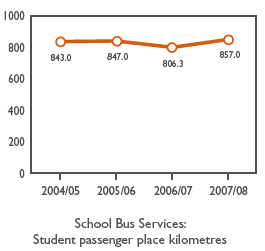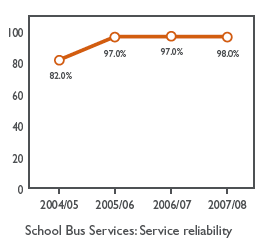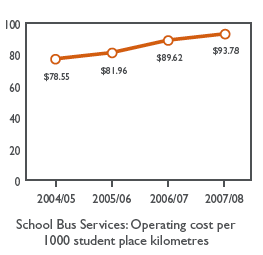The PTA manages the policy and entitlement framework, system management and contract management of more than 800 orange school buses View image around the State. These buses provide access to school for students in rural areas, picking them up from the farm gate (where appropriate), as well as providing access to schools in metropolitan areas for students attending special education facilities. Responsibility for the management of these services rests with the School Bus Services (SBS) branch within the PTA’s Transperth System, Regional and School Bus Services division.
In 2007/08, the school bus network comprised 693 school buses servicing mainstream schools, 117 school buses servicing special education facilities, and six regular public transport service arrangements.
These services were accessed by 26,000 students each school day around the State, using mainly the contracted orange school buses. Alternatively, where eligible students could not be accommodated on a school bus, their parents/carers were paid a conveyance allowance to help meet some of the costs incurred in getting their children to the nearest appropriate school.
Transport assistance was also provided to students attending special education facilities, mainly in large regional towns and in metropolitan Perth.
objectives and outcomes
| OBJECTIVE | OUTCOME |
|---|---|
|
Provide transport assistance for eligible students to assist them to attend their nearest government or non-government school offering the appropriate year of study. |
810 orange school bus contracts, which paid a conveyance allowance to entitled students at a total cost of $75.697 million. Including administration and seatbelt costs, total cost was $86.432 million. |
|
Ensure the transport assistance provided to students is appropriate, cost-effective, safe and fair in its application. |
Continued to manage the introduction of seat belts on government-funded school buses. Conducted two safety inspections on every school bus in the fleet during the year. |
|
Ensure that all service contracts are managed effectively and efficiently in accordance with agreements made between the Minister, the PTA and individual contractors and/or their representatives. |
Reviewed special education bus routes in metropolitan Perth and regional towns. Reviewed school bus routes that serve the fringes of metropolitan Perth. |
Cost of the service
The cost of providing 810 school bus services and payment conveyance allowance was $75.697 million in 2007/08. The inclusion of administration and seatbelt costs meant total costs for SBS were $86.432 million in 2007/08.
All orange school buses are operated by private contractors. Three contract/service models were used in 2007/08 to provide student transport support:
- Composite Rate Model (CRM) contracts (20-30 years in duration) – 693 contracts
- Fixed-term contracts (tendered over 1-15 years since 1995) – 117 contracts
- Regular passenger transport (licence arrangement with fare subsidy) – six arrangements
The CRM is an average cost model which was implemented in January 2004 and provides for contractor payments, with the cost elements of the payment model being reviewed over a three-year cycle by an independent review panel.
Description of services
In 2007/08, student passenger place kilometres rose by 6.3 per cent due to the increase in the number of school days in the year from 181 in 2006/07, to 186 in 2007/08, and the subsequent increase in passenger service kilometres.

The service reliability measure covers rural mainstream services and education support school buses operating in the Perth metropolitan area. The reliability measure is arrival less than 10 minutes before school starts and departure less than 10 minutes after school finishes.
In 2007/08, service reliability was 98 per cent, slightly higher then the previous year.

The operating cost per 1000 student passenger place kilometres increased by 4.6 per cent in 2007/08. This was due to an increase in service days, higher wage and fuel costs and the cost of implementing seatbelts.

The year’s developments
School bus routes were reviewed to maximise service delivery and efficiencies in metropolitan Perth.
School bus services to Busselton schools, and into the town centre, were reviewed to alleviate traffic congestion around the high schools and transfer areas where possible. Changes were implemented at the start of the school year.
A review was conducted in the Bindoon, Gingin, Lower Chittering, Muchea and Bullsbrook area to place students getting a conveyance allowance on to school bus services. As a result, a number of new orange school bus services will be commissioned in June 2009.
A review was conducted of school bus services operating around Geraldton. A number of services were realigned to provide more capacity for students living in and around Dongara to travel to schools in Geraldton.
The Loves Taxi and Bus Service, previously operating under a licensing arrangement in Bunbury, have signed a fixed-term contract. This replaces a licensing arrangement which had been in place since the mid-1970s, under which Loves had been paid a fare subsidy for students transported. This informal arrangement was not consistent with State Supply Commission requirements and has been replaced by a formal contract to provide transport services to students within a specified area.
Standardising the contract arrangements also entails standardising service delivery in the area covered by the contract so that, among other things, the buses used will meet the required school bus specifications, including the requirement that school buses be fitted with lap/sash seat belts.
Progress continued on the project to fit seat belts on all Government-funded school buses by December 2015. The contract awarded in January 2007 to Omnibus Services to retrofit 42 buses with seatbelts was completed in June 2008. Through normal bus replacement, 112 new buses with seatbelts entered the fleet and 28 buses were retrofitted during the year.
At the end of 2007/08 there were 288 school buses (35.5 per cent of the contracted fleet) fitted with seat belts.
With input from the Department of Education and Training, a new training package for bus aides on education support services was developed to help them better perform their duties.
Major initiatives for 2008/09
- Continue implementation of the Government policy to fit seat belts on all Government-funded school buses by 2015:
- Begin replacing with new buses, the ageing school bus fleet that feeds into Bunbury from surrounding rural areas
- Continue the review and, where required, introduce efficiency rationalisation of school bus routes as follows:
- Introduce new school bus services in Lower Chittering, Bullsbrook, Bindoon, Gingin and Muchea area for students attending schools in the Perth Public Transport Area.
- Review all school bus services operating in the greater Bunbury area.
- Develop a new service contract for the Department of Education and Training-funded transport assistance for Aboriginal Education Colleges.
- Continue liaison with the Department of Education and Training to review the student transport assistance policy with regard to:
- Integration of students with special needs into mainstream schools
- Integration of vocational studies into school curriculum through increased usage of TAFE facilities
- Review of transport provision when school facilities are opened or closed
- Roll out new training package to all bus aides employed on orange school buses.
